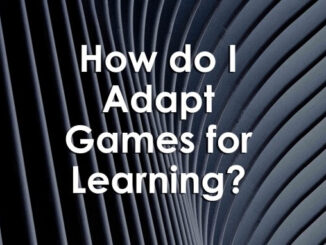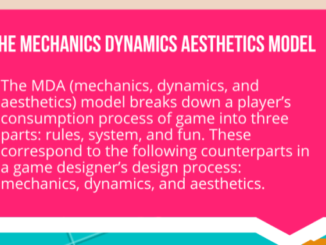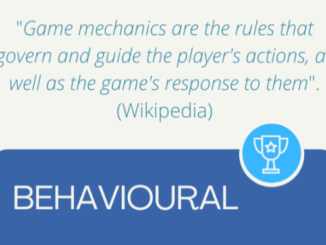
Arguably all ways in which a player can ‘win’ at a game can be expressed in the allocation of ‘points’ to that player. Even those games which do not, on the face of it, appear to use points as part of a scoring system do so. For example, the winning conditions of noughts and crosses (tic tac toe) could be described by allocating points for the (current highest) number of symbols which a player has managed to arrange in a line, with the winner being the first player to reach three points.
Winning often coincides with a conclusion to a game, with the winner therefore being the person who has reached the highest number of points ‘when the music stops’. Sometimes the winning condition itself is what triggers the end of the game. Therefore, it is common that people often talk about ‘sandbox’ games, such as Minecraft, or narrative-based games and RPGs, like Dungeons and Dragons as not having a win state. But viewed from this position of the allocation of points, we can see that this is not necessarily true. RPGs allow the player to achieve many ‘wins’, even though there may be no ‘winner’. All this actually tells us about such games is that they are not competitive (generally), and that there is no set conclusion condition, not that you cannot ‘win’ at them.

Winning in RPGS and Sandbox Games
Examples of points-based wins in RPGs include character stats, and their improvement throughout the game, payment for quests, and so on. In Minecraft, crafting of ever better materials and objects, utilising a Technology Tree represents a series of wins that could be described in terms of the increasing value of the objects to the player.
Given that all win states can be described mathematically, the actual perceived differences in win states between different games are more a matter for Aesthetics, Narrative and Theme than anything else. But of course, it is these elements of the design of a game which are most closely associated with the Player Experience. They are what makes the difference, for example, between a person simply pressing buttons in a pre-ordained sequence, in the manner of a pigeon in a Skinner Box, and a ‘player’ successfully getting his dragon to glide to the platform where the last few gems in the game are hidden.
The first of these looks a lot like ‘work’, and menial, tedious work at that, while the latter represents an achievement which leads to an experience of Fiero.
Winning Conditions
So, what kinds of different winning conditions can we create for the player. Here is a list of some commonly used ones – definitely not exhaustive.
- Victory Points – points accrued during the game as a result of player actions are totted up with the winner being the one with the most. This might also be implemented as money gained, number of skyscrapers built, or any other thing that can be simply ‘counted’
- Area control – the winner is the one who has control of the largest area of the game-playing surface.
- Race – the winner has reached some position, either figurative (a stated narratively described goal), or literal (a physical position on the playing surface) before all other players
- Target completion – the winner is the player who achieves some goal or set of goals before all other players. In turn the options for the targets are themselves almost limitless. It could be collecting sets of items, achieving a certain points score, or indeed any of the winning conditions listed here. It is worth remembered that win conditions can themselves be ‘chained’ or ‘grouped’ to provide larger ‘endgame’ win conditions.
- Last One Standing – Players are successively eliminated according to some criteria, until only one player – the winner – remains
- Codebreaking / Deduction – the winner is the one who arrives at some answer before all other players
Combining Mathematics with Aesthetics

And another list showing how these simple conditions can be combined with imaginative aesthetics, and some thematically appropriate mechanics, to create some of my favourite winning conditions in some of my favourite tabletop and party games.
- Victory Points – A combination of a playing surface that is created anew with each game, and the judicious placement of limited numbers or workers gives victory to the player who can complete the most cities, sequester the best grazing near to the cities, set up religious communities in well-tended land, and build the longest roads. All of which means that no two games of Carcassonne are ever the same.
- Area control – For fairly obvious thematic reasons many wargames have area control as a win condition. Good examples include Risk, and my particular favourite in this genre, Kingmaker. This condition is also often found in non-thematic, abstract ‘wargames’ – of which Go is the outstanding example. Many games also have area control as a central mechanic while the actual win condition is something else, like Victory Points – Carcassone, or the granddaddy of all area control games, El Grande.
- Race – Civilization (The board game not the Sid Meier epic – which is also awesome) is a pretty heavyweight game, which can take up to eight hours to play. Nevertheless, the win condition is simple – be the first to reach the end of a 17 space track. Thematically, you achieve that end through, variously, area control and advancing through a Technology Tree, representing the ever-advancing progress of your nation.
- Target completion – Games in which more than one target needs to be achieved in order to win, can make for experiences that are very strategic in nature, especially where targets interact with and modify each other. Fluxx uses this concept to make for a very dynamic play experience – with constantly changing goals and rules which modify each other.
- Last One Standing – Love Letter remains not only one of my favourite ‘last one standing’ games, but one of my favourite games ever. Thematically it reflects the intrigue of a medieval court, with hidden information as well as a kind of ‘Hot Potato’ mechanic, because while holding the princess at the end will win you the round, you also risk being forced to discard her (and therefore instantly losing) by the political machinations of your opponents.
- Codebreaking/ Deduction – The mainstay of many ‘detective’ games, which also understandably involve mechanics of hidden information. The ‘chase’ involved in Scotland Yard while trying to discover the location of the criminal ‘Mr X’, make sure this game immerses players well in the theme. It also arguably promotes the environmentally friendly use of public transport by public sector employees in the pursuit of their work.
Mapping Winning Conditions to Learning Outcomes

The flexibility in design afforded by this combination of simple mathematical calculation and aesthetics is another characteristic of games that make them suitable for creating learning experiences. When designing learning, with or without a game element, professionals must create objectives. In order to evaluate whether these objectives have been met, and measure the success of the learning intervention, they must also create some kind of measurement criteria. In an ideal world, these criteria should be objective (the clue is in the name) and therefore will themselves follow the same kind of ‘points’ structure that we have already discussed with reference to ‘winning’ a game – in that they should be measurable.
The potential for closely aligning the learning objectives, and evaluation criteria, with the game winning conditions, either mathematically, thematically, or both, gives learning game designers a head start over other learning professionals when devising ways to facilitate and assess learning.
One must also be careful not to create misalignment of these in the name of ‘fun’ (or anything else). For example, while a ‘fastest player wins’ condition might make for an exciting and energy-filled experience, if the learning outcomes relate to a workplace skill where careful reflection and consideration are more appropriate, use of the game may hinder, gather than aid learning outcomes.
A final visit, therefore, to the win conditions listed above, with suggestions for how they could be used in a learning setting.
- Victory Points – In Carcassonne you gather victory points from many different sources, which opens the way for differing strategies to achieve the same end. This approach can be useful for learning outcomes where there should be no ‘one true answer’, but the potential for learners to take an approach relevant and tailored to their own particular contexts and learning needs.
- Area control – The analogies for ‘area control’ in a workplace learning setting might cover such learning outcomes as ‘spheres of influence’ or ‘networking’, and more literally could be used in simulations for such applications as disaster recovery or training for humanitarian aid first response teams.
- Race – There are many ways in which organisations are involved in races – against each other, in order to be prepared before a new piece of legislation comes in, and so on. Think how this might be used in learning programmes about dealing with competition, or industry disruption, or even innovation programmes. A Race winning condition also works well in process improvement training, where repeated playing of a game should show improvement over previous instances
- Target completion – Fluxx is the card game equivalent of all those ‘Living in a VUCA world’ trainings we’ve all been on – because life is complex, and the goalposts keep shifting. Project Management training games should include multiple targets to complete – because, well, that’s how projects work.
- Last One Standing win conditions might seem a little harsh in a workplace learning setting. For many folk, workplaces already seem a little bit too much like a Battle Royale game without bringing it into the training room. However, if it is not people who are being eliminated, it can be well used, for example, for brainstorming and workshopping ideas and solutions. May the Odds be Ever in your Favour.
- Codebreaking/ Deduction works really well in teamworking and communication learning experiences, because they are an ideal way to get people together to share individual knowledge and synthesize it as a team – or to work to reach a shared understanding which is the eventual answer they need to solve the game. Other applications include learning around siloed teams, organisational culture and multicultural empathy.
Winning Condition Takeaways
While all the above is underpinned by counting up ‘points’ the potential for creating variety in the experience of ‘winning’ for your learners goes way beyond simply coming up with a numeric score and declaring one of the teams in the room the ‘winner’. In workplace settings, it is unlikely that employees’ day to day experience of workplace will include them being ‘scored’, so why would we, as learning designers, create workplace learning experience with scores as an output. Most of the feedback they get from decisions and actions at work will be in the form of sensory and emotional experience – so shouldn’t their learning feedback work in the same way? Judicious use of theme, aesthetics and well-chosen mechanics will result in win conditions with greater relevance and applicability to the skills they have come along to learn.
- James Bore – The Ransomeware Game - 13th February 2024
- Ipsodeckso – Risky Business - 23rd January 2024
- Review – Luma World Games - 15th December 2023





Be the first to comment